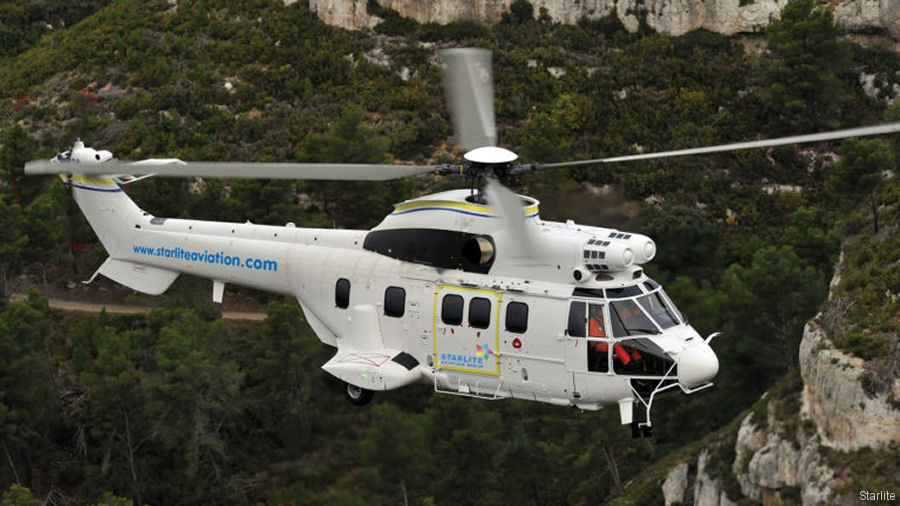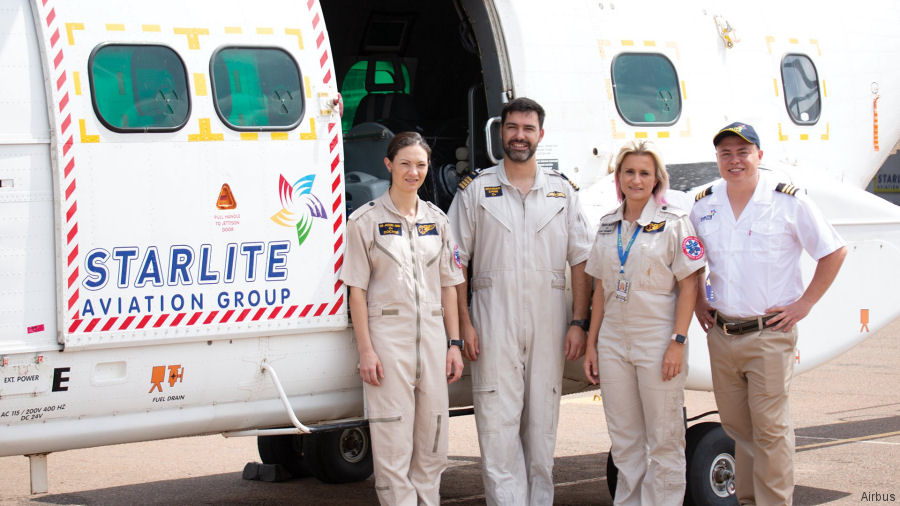
Airbus Helicopters, January 30, 2021 - Starlite currently operates three H215s for the European Union mission in West Africa’s Republic of Mali, which aims to restore lasting peace in this country. Two of the three aircraft are used to support the European Union Training Mission (EUTM), and also provide medical evacuation of any EU personnel deployed there.
MEDEVAC pilot Captain Daniel Erasmus and Starlite Flight Physician Dr. Jacqui Amm discuss their daily challenges.
What exactly are you doing to support the European Union Training Mission in Mali?
Captain Daniel Erasmus: Part of the mission is to be on a 24/7 standby and ready to react to any medical emergency. We handle everything from vehicle accidents to inter-hospital transfers and supporting convoy movements between towns. Response time required can range from 15 to 30 minutes depending on the mission; our focus is not only to get the patient from point A to point B, but also to get the medical personnel to the patient as quickly as possible.
Dr. Jacqui Amm: Our main service onboard involves monitoring the patient’s condition while continuing the care that was commenced prior to loading the patient. We also are responsible for ensuring patient safety during the flight, even if, as far as possible, the patient will be treated and stabilised on the ground before being transferred onto the aircraft. Should the patient require medical interventions during the flight, we are also able to provide these.
The evacuation of a patient is teamwork. What is involved from your perspective from call to action, patient pick-up and delivery to a medical facility?
Erasmus: When we get a call out, we have a quick meeting between the team members to discuss the mission on hand and what we expect from each other. We will decide together whether it is safe and appropriate to accept the task. It is the pilot’s responsibility to get the medical team to the patient as soon as possible. We need to closely monitor the weather, as Mali is a landlocked country with a variety of seasonal weather conditions from week-long sand storms to intense tropical storms and microbursts, along with year-round heat extremes.
Amm: The Medical Team Leader will obtain as much information as possible about the patient, prior to the flight leaving, in order to be as well-prepared as possible for the potential conditions they will have to treat. Upon arrival on scene, the crew will determine whether the aircraft can shut down completely while the patient is assessed and treated, or whether the environment is too unsafe (in which case, the medical crew may need to perform a “hot onload” of the patient, with the helicopter engines still running). On arrival at the appropriate destination, the patient will be offloaded from the aircraft by the medical team and handed over to medical staff at the receiving facility.
And then ready again for the next mission?
Amm: Well, after the transfer we will route back to base to refuel. The crew still needs to unpack the aircraft, sterilise medical equipment, replace any drugs or consumables that were used and complete the patient report form. Once everything has been documented, the crew will debrief on the case, as an opportunity to look for any improvements that can be made and ensure that as a cohesive unit, everyone is comfortable with the way the case was handled. This is when we are again ready for the next call out.
Has the COVID-19 situation changed your work routines in any way?
Erasmus: We have been trained to deal with COVID-19 patients by Starlite. Prior to deployment, we received an online course to understand the COVID-19 pandemic and the safe travel practices. On reaching base, the medical team took the pilots through a step-by-step demonstration of the hazmat suits we would have to wear and the protocols in the event of transporting a COVID-19 passenger. The helicopter’s cockpit has been isolated as well for extra protection.
H215: tailored for challenging environments
The H215 has already demonstrated its ability to perform medical evacuation in the context of humanitarian missions with Starlite in Mali and Kosovo for EU operations.
Within Airbus´ Super Puma family, this helicopter is legendary for its rugged design, excellent payload lift performance, and demonstrated ability to operate in the most austere environments – including humanitarian, military and disaster relief missions.
The H215 offers a long-range capability and a high seating capacity (19 passengers plus two pilots within H215’s long version) perfectly tailored for the “3H” scenarios: high, hot and hostile.
MEDEVAC pilot Captain Daniel Erasmus and Starlite Flight Physician Dr. Jacqui Amm discuss their daily challenges.
What exactly are you doing to support the European Union Training Mission in Mali?
Captain Daniel Erasmus: Part of the mission is to be on a 24/7 standby and ready to react to any medical emergency. We handle everything from vehicle accidents to inter-hospital transfers and supporting convoy movements between towns. Response time required can range from 15 to 30 minutes depending on the mission; our focus is not only to get the patient from point A to point B, but also to get the medical personnel to the patient as quickly as possible.
Dr. Jacqui Amm: Our main service onboard involves monitoring the patient’s condition while continuing the care that was commenced prior to loading the patient. We also are responsible for ensuring patient safety during the flight, even if, as far as possible, the patient will be treated and stabilised on the ground before being transferred onto the aircraft. Should the patient require medical interventions during the flight, we are also able to provide these.
The evacuation of a patient is teamwork. What is involved from your perspective from call to action, patient pick-up and delivery to a medical facility?
Erasmus: When we get a call out, we have a quick meeting between the team members to discuss the mission on hand and what we expect from each other. We will decide together whether it is safe and appropriate to accept the task. It is the pilot’s responsibility to get the medical team to the patient as soon as possible. We need to closely monitor the weather, as Mali is a landlocked country with a variety of seasonal weather conditions from week-long sand storms to intense tropical storms and microbursts, along with year-round heat extremes.
Amm: The Medical Team Leader will obtain as much information as possible about the patient, prior to the flight leaving, in order to be as well-prepared as possible for the potential conditions they will have to treat. Upon arrival on scene, the crew will determine whether the aircraft can shut down completely while the patient is assessed and treated, or whether the environment is too unsafe (in which case, the medical crew may need to perform a “hot onload” of the patient, with the helicopter engines still running). On arrival at the appropriate destination, the patient will be offloaded from the aircraft by the medical team and handed over to medical staff at the receiving facility.
And then ready again for the next mission?
Amm: Well, after the transfer we will route back to base to refuel. The crew still needs to unpack the aircraft, sterilise medical equipment, replace any drugs or consumables that were used and complete the patient report form. Once everything has been documented, the crew will debrief on the case, as an opportunity to look for any improvements that can be made and ensure that as a cohesive unit, everyone is comfortable with the way the case was handled. This is when we are again ready for the next call out.
Has the COVID-19 situation changed your work routines in any way?
Erasmus: We have been trained to deal with COVID-19 patients by Starlite. Prior to deployment, we received an online course to understand the COVID-19 pandemic and the safe travel practices. On reaching base, the medical team took the pilots through a step-by-step demonstration of the hazmat suits we would have to wear and the protocols in the event of transporting a COVID-19 passenger. The helicopter’s cockpit has been isolated as well for extra protection.
H215: tailored for challenging environments
The H215 has already demonstrated its ability to perform medical evacuation in the context of humanitarian missions with Starlite in Mali and Kosovo for EU operations.
Within Airbus´ Super Puma family, this helicopter is legendary for its rugged design, excellent payload lift performance, and demonstrated ability to operate in the most austere environments – including humanitarian, military and disaster relief missions.
The H215 offers a long-range capability and a high seating capacity (19 passengers plus two pilots within H215’s long version) perfectly tailored for the “3H” scenarios: high, hot and hostile.

H215 / AS332C1e / AS332L1e ZT-RYC ZT-RYB ZT-RYD
Comments | Join community |
| Not the job of civilian chopper/pilots. It shows the lack of investment in this conflict. A larger coalition should be here to chase the terrorists in this region. |
| As there is no more H215 under Starlite Ireland Why not working with Airtelis French company on H215 and H225 to support French Army in Mali ???? Instead of working with Starlite Johannesburg under European Union Training Mission !!! |
See also |
H215 / AS332C1e / AS332L1e in
MINUSMA United Nations
EUTM European Union Training Mission European Commission




